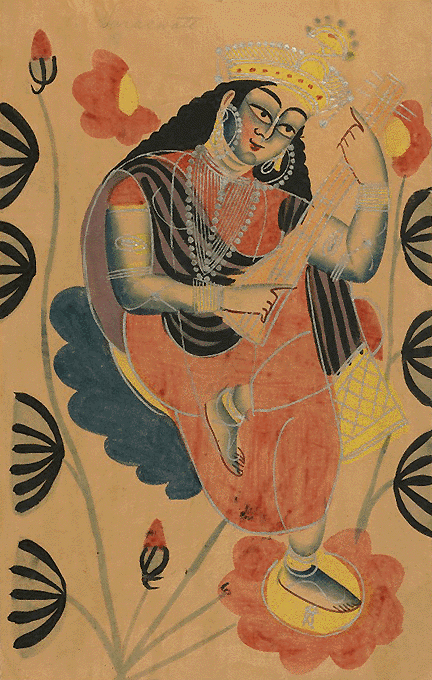
|
|
|
|
Shiva, of course, knew this was untrue, and he became very angry at Brahma's for his trickery. He then cursed Brahma, saying: "Oh Chaturmugha, for your base lies, may you not have any temple on earth. You deserve it not. And as for the Thazhampoo, it will never be used in my worship again." Shiva's flame then transformed into the famed Arunachala Hills. There are many temples in this locale who claim to reside in the region of this great pastime. We have discovered quite a number of temples where Lord Brahma is worshipped, regardless of any great curse put against him, although the number of such places is miniscule compared to the number of Krsna, Visnu and Shiva temples throughout India. Likewise, we saw yesterday the short list of Saraswati temples. Look all chaste wives, Saraswati accepts whatever circumstances befall her husband, and she, too, has far fewer temples than Laksmi Devi or Parvati Devi. The Saraswati Temple at Kuthanur, featured yesterday, is appears to be the most prominent of all Saraswati temples. Because there are so many interesting pastimes associated with it, and since it is like to be the only Saraswati temple we cover in this series, we would like to dedicate a second segment to the pastimes leading up to the establishment of Saraswati Devi's Temple at Kuthanur. As mentioned yesterday, the temple was built on the banks of the Arisalaar, a tributary of the Kaveri River, by the famed Tamil poet, Ottakoothar. The town was named Koothanur in his honor. The land for the temple was gifted by the Chozha kings, who he served as their chief court poet. Kings Kulothungan, Vikraman, and Rajarajan II were all glorified by Ottakoothar, who was a member of their court. While history has it that the King gave the land to Ottakoothar because of his great devotion to Saraswati, it is said that Saraswati Devi herself chose this land. There was a time when Dakshayini had been reborn to Parvatharajan as Parvati. Coming to a suitable age for marriage, she intended to wed her lord, Parameshwara (Shiva). Intending to perform great austerities to please him, she went into a forest of sacred Vilva trees, known as Vilvavanam, and began her penance there to get Shiva's hand. In her presence, the forest blossomed with flowers, and the birds all sang. Shiva, being very pleased with her devotions, prepared to approach Parvatharajan, and ask permission to marry her. But it seems there was an obstacle in his way… Ganga Ma. Ganga Devi, the second wife of Shiva, was eternally residing in his matted locks, trickling down the Himalayas and flowing across Mother Bharata. Not wanted Parvati's father to know of her close presence, he transformed Ganga Ma into a young girl, and himself into a Brahmin. He Ganga over to the care of Bhaskara Muni while he ostensibly went on pilgrimage, and because the Muni was himself engaged in a penance to please Shiva, he gladly took Ganga in and cared for her like his own daughter. On the fateful day Shiva was to see Parvatharajan, Bhaskara Muni went to the banks of the Arisol Aaru (river) to take bath. Having forgotten his kamandala, he called to Ganga to get it for him. She went at once, but upon handling the kamandala, she suddenly remembered her real identity. She at once merged with the Arisol, and flowed away. The Muni was shocked, and afraid to tell Shiva what had happened when he returned, but he eventually admitted the turn of events, and got Shiva's blessing. The place where Ganga merged with the Arisol Aaru came to be known as Rudragangai. Because Gauri had performed her penance there, it is also known as Gaurivanam.

Lord Brahma Kalighat painting, c. 1940 On day, many eons later, a dispute arose at Brahma Loka between Brahma and Vani. The two were arguing that Brahma Loka had attained its great fame due to their own presence, not the other's. Saraswati insisted that if she were to leave, Brahmaloka would immediately lose its sheen. Each ended up cursing the other, and as a result, they were later born into the family of a Brahmin named Punyakeerthi, as his son and daughter. The son, Bagukanthan, and the daughter, Shraddhai, eventually came to marriageable age. As their father began to search for suitable matches, they realized the predicament they were in, and prayed to Shiva for assistance. "Saraswati!" -- cried a voice from the heavens, "Go to the Rudragangai River near Gaurivanam and merge there with the waters. You will soon be honored with a temple near Arisol Aaru. Stay there as Maha Saraswati and shower your grace on those who come to you." Brahma was also relieved of the curse, and also asked Shiva to overturn the previous curse, limiting his worship. Mahadeva replies, "Brahma, though you will not have any temples on earth, in all Pitr Karmas you will be invocated with the Brahma Pooja. People will worship you this way." With that, Shiva disappeared. As instructed, Saraswati went to the Rudragangai and merged herself with the waters there. Much later, when Yamuna Devi was suffering the doshas of people who bathed in her water, Sri Krsna suggested that she would get relief by bathing herself in the Rudragangai, meditating there on Shiva. So Yamuna also merged into the Rudragangai. The confluence of Ganga, Yamuna and Saraswati into the Arisol Aaru has come to be known as Dakshina Triveni Sangamam. And at this sacred spot, Saraswati Devi herself is said to have chosen for her temple to be built, at Kuthanur.
| |

